Xin Cheng
Fellow, IEEE
DeepSeek-V3 Technical Report
Dec 27, 2024



Abstract:We present DeepSeek-V3, a strong Mixture-of-Experts (MoE) language model with 671B total parameters with 37B activated for each token. To achieve efficient inference and cost-effective training, DeepSeek-V3 adopts Multi-head Latent Attention (MLA) and DeepSeekMoE architectures, which were thoroughly validated in DeepSeek-V2. Furthermore, DeepSeek-V3 pioneers an auxiliary-loss-free strategy for load balancing and sets a multi-token prediction training objective for stronger performance. We pre-train DeepSeek-V3 on 14.8 trillion diverse and high-quality tokens, followed by Supervised Fine-Tuning and Reinforcement Learning stages to fully harness its capabilities. Comprehensive evaluations reveal that DeepSeek-V3 outperforms other open-source models and achieves performance comparable to leading closed-source models. Despite its excellent performance, DeepSeek-V3 requires only 2.788M H800 GPU hours for its full training. In addition, its training process is remarkably stable. Throughout the entire training process, we did not experience any irrecoverable loss spikes or perform any rollbacks. The model checkpoints are available at https://github.com/deepseek-ai/DeepSeek-V3.
Cycle-Constrained Adversarial Denoising Convolutional Network for PET Image Denoising: Multi-Dimensional Validation on Large Datasets with Reader Study and Real Low-Dose Data
Oct 31, 2024Abstract:Positron emission tomography (PET) is a critical tool for diagnosing tumors and neurological disorders but poses radiation risks to patients, particularly to sensitive populations. While reducing injected radiation dose mitigates this risk, it often compromises image quality. To reconstruct full-dose-quality images from low-dose scans, we propose a Cycle-constrained Adversarial Denoising Convolutional Network (Cycle-DCN). This model integrates a noise predictor, two discriminators, and a consistency network, and is optimized using a combination of supervised loss, adversarial loss, cycle consistency loss, identity loss, and neighboring Structural Similarity Index (SSIM) loss. Experiments were conducted on a large dataset consisting of raw PET brain data from 1,224 patients, acquired using a Siemens Biograph Vision PET/CT scanner. Each patient underwent a 120-seconds brain scan. To simulate low-dose PET conditions, images were reconstructed from shortened scan durations of 30, 12, and 5 seconds, corresponding to 1/4, 1/10, and 1/24 of the full-dose acquisition, respectively, using a custom-developed GPU-based image reconstruction software. The results show that Cycle-DCN significantly improves average Peak Signal-to-Noise Ratio (PSNR), SSIM, and Normalized Root Mean Square Error (NRMSE) across three dose levels, with improvements of up to 56%, 35%, and 71%, respectively. Additionally, it achieves contrast-to-noise ratio (CNR) and Edge Preservation Index (EPI) values that closely align with full-dose images, effectively preserving image details, tumor shape, and contrast, while resolving issues with blurred edges. The results of reader studies indicated that the images restored by Cycle-DCN consistently received the highest ratings from nuclear medicine physicians, highlighting their strong clinical relevance.
AFlow: Automating Agentic Workflow Generation
Oct 14, 2024



Abstract:Large language models (LLMs) have demonstrated remarkable potential in solving complex tasks across diverse domains, typically by employing agentic workflows that follow detailed instructions and operational sequences. However, constructing these workflows requires significant human effort, limiting scalability and generalizability. Recent research has sought to automate the generation and optimization of these workflows, but existing methods still rely on initial manual setup and fall short of achieving fully automated and effective workflow generation. To address this challenge, we reformulate workflow optimization as a search problem over code-represented workflows, where LLM-invoking nodes are connected by edges. We introduce AFlow, an automated framework that efficiently explores this space using Monte Carlo Tree Search, iteratively refining workflows through code modification, tree-structured experience, and execution feedback. Empirical evaluations across six benchmark datasets demonstrate AFlow's efficacy, yielding a 5.7% average improvement over state-of-the-art baselines. Furthermore, AFlow enables smaller models to outperform GPT-4o on specific tasks at 4.55% of its inference cost in dollars. The code will be available at https://github.com/geekan/MetaGPT.
PersonaMath: Enhancing Math Reasoning through Persona-Driven Data Augmentation
Oct 02, 2024



Abstract:While closed-source Large Language Models (LLMs) demonstrate strong mathematical problem-solving abilities, open-source models continue to struggle with such tasks. To bridge this gap, we propose a data augmentation approach and introduce PersonaMathQA, a dataset derived from MATH and GSM8K, on which we train the PersonaMath models. Our approach consists of two stages: the first stage is learning from Persona Diversification, and the second stage is learning from Reflection. In the first stage, we regenerate detailed chain-of-thought (CoT) solutions as instructions using a closed-source LLM and introduce a novel persona-driven data augmentation technique to enhance the dataset's quantity and diversity. In the second stage, we incorporate reflection to fully leverage more challenging and valuable questions. Evaluation of our PersonaMath models on MATH and GSM8K reveals that the PersonaMath-7B model (based on LLaMA-2-7B) achieves an accuracy of 24.2% on MATH and 68.7% on GSM8K, surpassing all baseline methods and achieving state-of-the-art performance. Notably, our dataset contains only 70.3K data points-merely 17.8% of MetaMathQA and 27% of MathInstruct-yet our model outperforms these baselines, demonstrating the high quality and diversity of our dataset, which enables more efficient model training. We open-source the PersonaMathQA dataset, PersonaMath models, and our code for public usage.
ChipExpert: The Open-Source Integrated-Circuit-Design-Specific Large Language Model
Jul 26, 2024Abstract:The field of integrated circuit (IC) design is highly specialized, presenting significant barriers to entry and research and development challenges. Although large language models (LLMs) have achieved remarkable success in various domains, existing LLMs often fail to meet the specific needs of students, engineers, and researchers. Consequently, the potential of LLMs in the IC design domain remains largely unexplored. To address these issues, we introduce ChipExpert, the first open-source, instructional LLM specifically tailored for the IC design field. ChipExpert is trained on one of the current best open-source base model (Llama-3 8B). The entire training process encompasses several key stages, including data preparation, continue pre-training, instruction-guided supervised fine-tuning, preference alignment, and evaluation. In the data preparation stage, we construct multiple high-quality custom datasets through manual selection and data synthesis techniques. In the subsequent two stages, ChipExpert acquires a vast amount of IC design knowledge and learns how to respond to user queries professionally. ChipExpert also undergoes an alignment phase, using Direct Preference Optimization, to achieve a high standard of ethical performance. Finally, to mitigate the hallucinations of ChipExpert, we have developed a Retrieval-Augmented Generation (RAG) system, based on the IC design knowledge base. We also released the first IC design benchmark ChipICD-Bench, to evaluate the capabilities of LLMs across multiple IC design sub-domains. Through comprehensive experiments conducted on this benchmark, ChipExpert demonstrated a high level of expertise in IC design knowledge Question-and-Answer tasks.
Flexible and Adaptable Summarization via Expertise Separation
Jun 08, 2024



Abstract:A proficient summarization model should exhibit both flexibility -- the capacity to handle a range of in-domain summarization tasks, and adaptability -- the competence to acquire new knowledge and adjust to unseen out-of-domain tasks. Unlike large language models (LLMs) that achieve this through parameter scaling, we propose a more parameter-efficient approach in this study. Our motivation rests on the principle that the general summarization ability to capture salient information can be shared across different tasks, while the domain-specific summarization abilities need to be distinct and tailored. Concretely, we propose MoeSumm, a Mixture-of-Expert Summarization architecture, which utilizes a main expert for gaining the general summarization capability and deputy experts that selectively collaborate to meet specific summarization task requirements. We further propose a max-margin loss to stimulate the separation of these abilities. Our model's distinct separation of general and domain-specific summarization abilities grants it with notable flexibility and adaptability, all while maintaining parameter efficiency. MoeSumm achieves flexibility by managing summarization across multiple domains with a single model, utilizing a shared main expert and selected deputy experts. It exhibits adaptability by tailoring deputy experts to cater to out-of-domain few-shot and zero-shot scenarios. Experimental results on 11 datasets show the superiority of our model compared with recent baselines and LLMs. We also provide statistical and visual evidence of the distinct separation of the two abilities in MoeSumm (https://github.com/iriscxy/MoE_Summ).
P$^2$-ViT: Power-of-Two Post-Training Quantization and Acceleration for Fully Quantized Vision Transformer
May 30, 2024Abstract:Vision Transformers (ViTs) have excelled in computer vision tasks but are memory-consuming and computation-intensive, challenging their deployment on resource-constrained devices. To tackle this limitation, prior works have explored ViT-tailored quantization algorithms but retained floating-point scaling factors, which yield non-negligible re-quantization overhead, limiting ViTs' hardware efficiency and motivating more hardware-friendly solutions. To this end, we propose \emph{P$^2$-ViT}, the first \underline{P}ower-of-Two (PoT) \underline{p}ost-training quantization and acceleration framework to accelerate fully quantized ViTs. Specifically, {as for quantization,} we explore a dedicated quantization scheme to effectively quantize ViTs with PoT scaling factors, thus minimizing the re-quantization overhead. Furthermore, we propose coarse-to-fine automatic mixed-precision quantization to enable better accuracy-efficiency trade-offs. {In terms of hardware,} we develop {a dedicated chunk-based accelerator} featuring multiple tailored sub-processors to individually handle ViTs' different types of operations, alleviating reconfigurable overhead. Additionally, we design {a tailored row-stationary dataflow} to seize the pipeline processing opportunity introduced by our PoT scaling factors, thereby enhancing throughput. Extensive experiments consistently validate P$^2$-ViT's effectiveness. {Particularly, we offer comparable or even superior quantization performance with PoT scaling factors when compared to the counterpart with floating-point scaling factors. Besides, we achieve up to $\mathbf{10.1\times}$ speedup and $\mathbf{36.8\times}$ energy saving over GPU's Turing Tensor Cores, and up to $\mathbf{1.84\times}$ higher computation utilization efficiency against SOTA quantization-based ViT accelerators. Codes are available at \url{https://github.com/shihuihong214/P2-ViT}.
xRAG: Extreme Context Compression for Retrieval-augmented Generation with One Token
May 22, 2024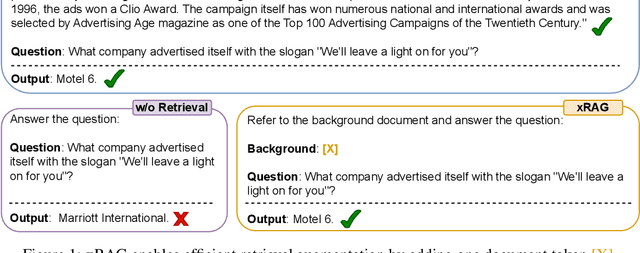
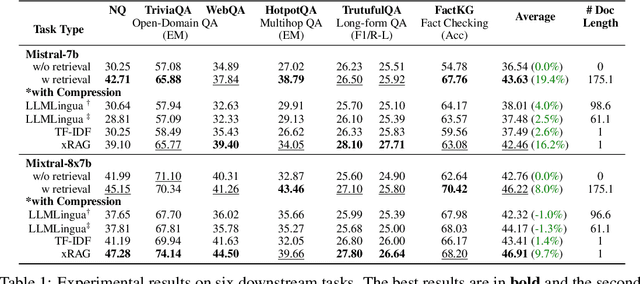
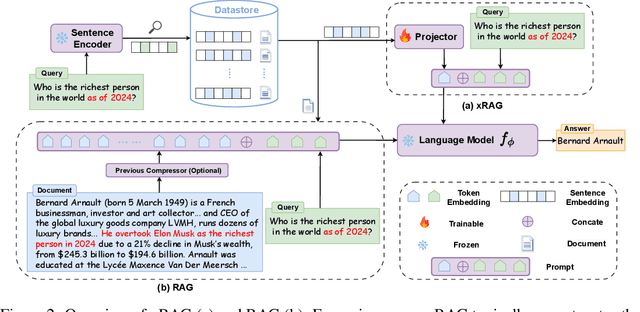

Abstract:This paper introduces xRAG, an innovative context compression method tailored for retrieval-augmented generation. xRAG reinterprets document embeddings in dense retrieval--traditionally used solely for retrieval--as features from the retrieval modality. By employing a modality fusion methodology, xRAG seamlessly integrates these embeddings into the language model representation space, effectively eliminating the need for their textual counterparts and achieving an extreme compression rate. In xRAG, the only trainable component is the modality bridge, while both the retriever and the language model remain frozen. This design choice allows for the reuse of offline-constructed document embeddings and preserves the plug-and-play nature of retrieval augmentation. Experimental results demonstrate that xRAG achieves an average improvement of over 10% across six knowledge-intensive tasks, adaptable to various language model backbones, ranging from a dense 7B model to an 8x7B Mixture of Experts configuration. xRAG not only significantly outperforms previous context compression methods but also matches the performance of uncompressed models on several datasets, while reducing overall FLOPs by a factor of 3.53. Our work pioneers new directions in retrieval-augmented generation from the perspective of multimodality fusion, and we hope it lays the foundation for future efficient and scalable retrieval-augmented systems
Leveraging 2D Information for Long-term Time Series Forecasting with Vanilla Transformers
May 22, 2024
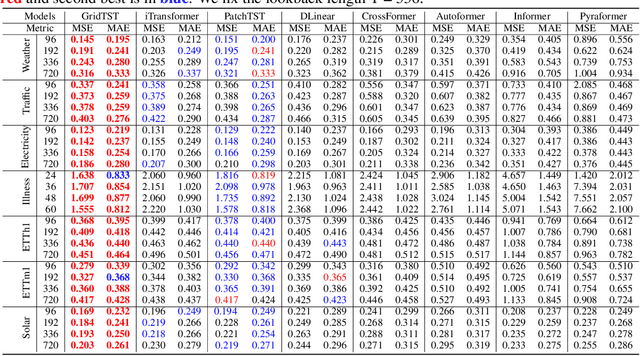
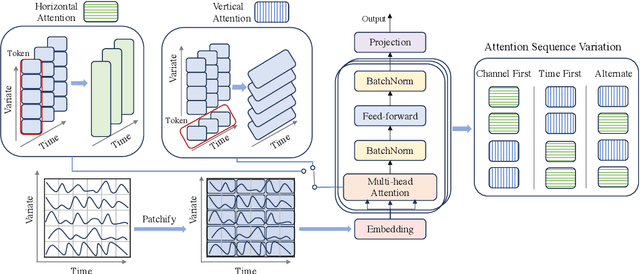
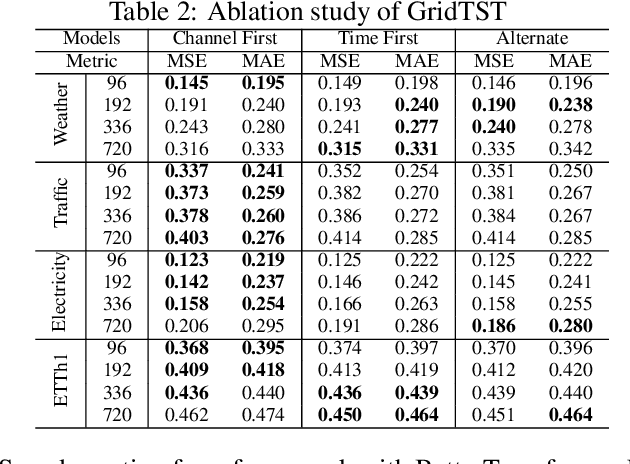
Abstract:Time series prediction is crucial for understanding and forecasting complex dynamics in various domains, ranging from finance and economics to climate and healthcare. Based on Transformer architecture, one approach involves encoding multiple variables from the same timestamp into a single temporal token to model global dependencies. In contrast, another approach embeds the time points of individual series into separate variate tokens. The former method faces challenges in learning variate-centric representations, while the latter risks missing essential temporal information critical for accurate forecasting. In our work, we introduce GridTST, a model that combines the benefits of two approaches using innovative multi-directional attentions based on a vanilla Transformer. We regard the input time series data as a grid, where the $x$-axis represents the time steps and the $y$-axis represents the variates. A vertical slicing of this grid combines the variates at each time step into a \textit{time token}, while a horizontal slicing embeds the individual series across all time steps into a \textit{variate token}. Correspondingly, a \textit{horizontal attention mechanism} focuses on time tokens to comprehend the correlations between data at various time steps, while a \textit{vertical}, variate-aware \textit{attention} is employed to grasp multivariate correlations. This combination enables efficient processing of information across both time and variate dimensions, thereby enhancing the model's analytical strength. % We also integrate the patch technique, segmenting time tokens into subseries-level patches, ensuring that local semantic information is retained in the embedding. The GridTST model consistently delivers state-of-the-art performance across various real-world datasets.
StyleChat: Learning Recitation-Augmented Memory in LLMs for Stylized Dialogue Generation
Mar 18, 2024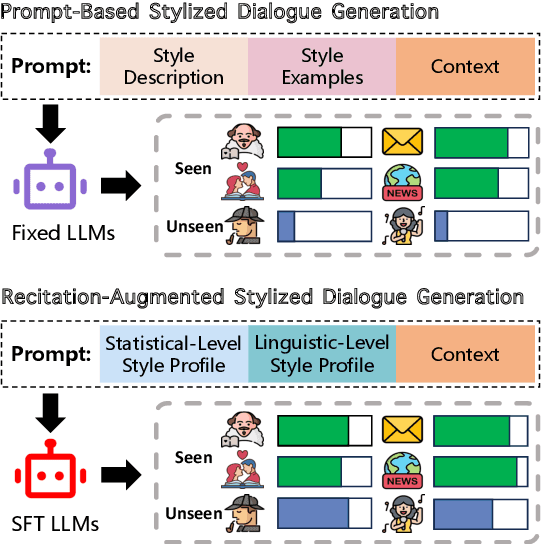
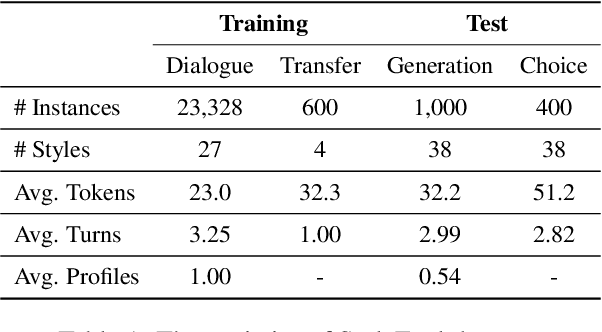
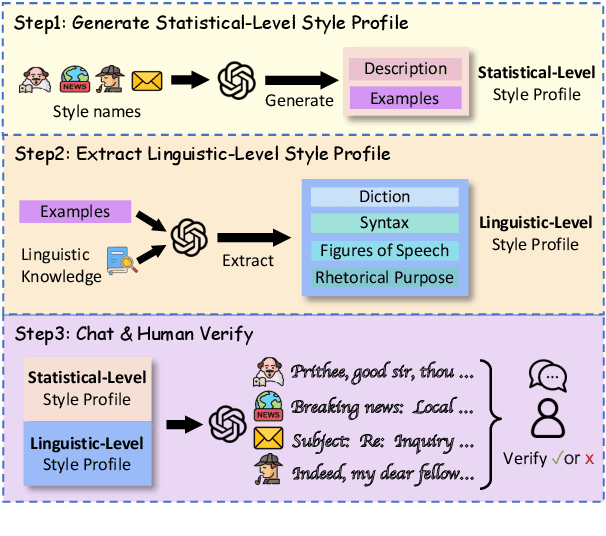

Abstract:Large Language Models (LLMs) demonstrate superior performance in generative scenarios and have attracted widespread attention. Among them, stylized dialogue generation is essential in the context of LLMs for building intelligent and engaging dialogue agent. However the ability of LLMs is data-driven and limited by data bias, leading to poor performance on specific tasks. In particular, stylized dialogue generation suffers from a severe lack of supervised data. Furthermore, although many prompt-based methods have been proposed to accomplish specific tasks, their performance in complex real-world scenarios involving a wide variety of dialog styles further enhancement. In this work, we first introduce a stylized dialogue dataset StyleEval with 38 styles by leveraging the generative power of LLMs comprehensively, which has been carefully constructed with rigorous human-led quality control. Based on this, we propose the stylized dialogue framework StyleChat via recitation-augmented memory strategy and multi-task style learning strategy to promote generalization ability. To evaluate the effectiveness of our approach, we created a test benchmark that included both a generation task and a choice task to comprehensively evaluate trained models and assess whether styles and preferences are remembered and understood. Experimental results show that our proposed framework StyleChat outperforms all the baselines and helps to break the style boundary of LLMs.
 Add to Chrome
Add to Chrome Add to Firefox
Add to Firefox Add to Edge
Add to Edge